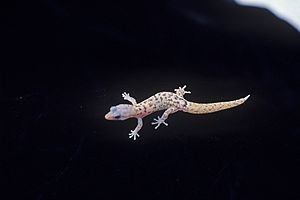Monito gecko facts for kids
Quick facts for kids Monito gecko |
|
|---|---|
 |
|
| Conservation status | |
| Scientific classification | |
| Genus: |
Sphaerodactylus
|
| Species: |
micropithecus
|
The Monito gecko (Sphaerodactylus micropithecus) is a small lizard. It is a type of gecko found only on Monito Island, which is part of Puerto Rico. Being "endemic" means it lives naturally in just one place in the world.
Contents
Where the Monito Gecko Lives
The Monito gecko lives in only two spots on Monito Island. One area is near a sea cave on the island's northwest side. The other is on the northeast side, close to a place called Castle Rock. This area is about 500 by 300 meters, which is a small space.
Scientists first found this gecko in May 1974. They discovered one adult gecko and an egg on Monito Island.
Protecting the Monito Gecko
For a long time, there were not many Monito geckos. Scientists thought this was because rats were brought to Monito Island. These rats might have eaten the geckos or their eggs. Also, United States Navy bombing practices after World War II may have harmed their home.
In 1982, a study looked for these geckos. They found only 18 of them. Because of how few there were, the United States Fish and Wildlife Service added the Monito gecko to the endangered species list on October 15, 1982. This meant it was in danger of disappearing forever.
Good news! The Puerto Rico Department of Natural Environmental and Resources worked to remove the rats from the island in 1992 and 1999. Since the rats were gone, the geckos have been doing much better. In 2018, it was suggested that they might no longer need to be on the endangered species list!
What the Monito Gecko Looks Like
We don't know a lot about the Monito gecko because it is quite rare. It is light gray to tan in color. It also has darker spots on its back. These geckos are very small, growing up to about 36 millimeters long from their snout to the base of their tail.
Monito Gecko's Diet and Life Cycle
Scientists believe the Monito gecko eats insects, just like many other geckos. They might also eat other small creatures.
We don't have much information about how they reproduce. However, it is thought that their breeding season is from March to November. Females likely lay one or two eggs. These eggs then hatch in about two to three months. Unlike most geckos, which are active at night, the Monito gecko is diurnal. This means it is active during the day!
See also
 In Spanish: Salamanquita de Monito para niños
In Spanish: Salamanquita de Monito para niños


